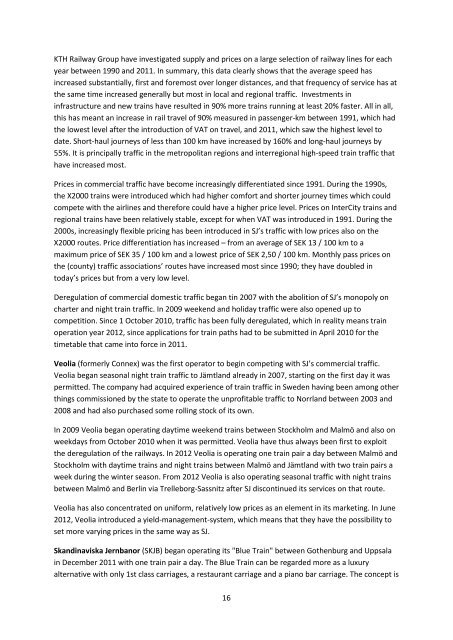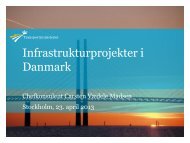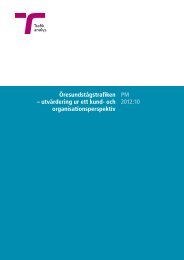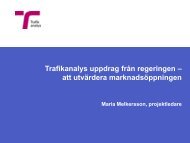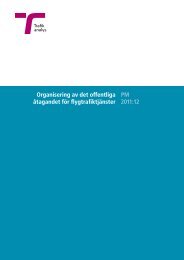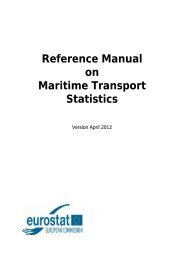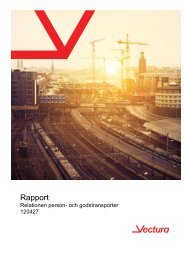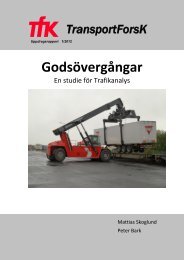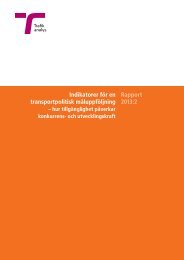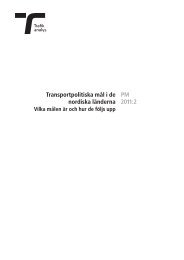KTH: Utbud priser och avreglering 1990-2011 - Trafikanalys
KTH: Utbud priser och avreglering 1990-2011 - Trafikanalys
KTH: Utbud priser och avreglering 1990-2011 - Trafikanalys
You also want an ePaper? Increase the reach of your titles
YUMPU automatically turns print PDFs into web optimized ePapers that Google loves.
<strong>KTH</strong> Railway Group have investigated supply and prices on a large selection of railway lines for each<br />
year between <strong>1990</strong> and <strong>2011</strong>. In summary, this data clearly shows that the average speed has<br />
increased substantially, first and foremost over longer distances, and that frequency of service has at<br />
the same time increased generally but most in local and regional traffic. Investments in<br />
infrastructure and new trains have resulted in 90% more trains running at least 20% faster. All in all,<br />
this has meant an increase in rail travel of 90% measured in passenger-km between 1991, which had<br />
the lowest level after the introduction of VAT on travel, and <strong>2011</strong>, which saw the highest level to<br />
date. Short-haul journeys of less than 100 km have increased by 160% and long-haul journeys by<br />
55%. It is principally traffic in the metropolitan regions and interregional high-speed train traffic that<br />
have increased most.<br />
Prices in commercial traffic have become increasingly differentiated since 1991. During the <strong>1990</strong>s,<br />
the X2000 trains were introduced which had higher comfort and shorter journey times which could<br />
compete with the airlines and therefore could have a higher price level. Prices on InterCity trains and<br />
regional trains have been relatively stable, except for when VAT was introduced in 1991. During the<br />
2000s, increasingly flexible pricing has been introduced in SJ’s traffic with low prices also on the<br />
X2000 routes. Price differentiation has increased – from an average of SEK 13 / 100 km to a<br />
maximum price of SEK 35 / 100 km and a lowest price of SEK 2,50 / 100 km. Monthly pass prices on<br />
the (county) traffic associations’ routes have increased most since <strong>1990</strong>; they have doubled in<br />
today’s prices but from a very low level.<br />
Deregulation of commercial domestic traffic began tin 2007 with the abolition of SJ’s monopoly on<br />
charter and night train traffic. In 2009 weekend and holiday traffic were also opened up to<br />
competition. Since 1 October 2010, traffic has been fully deregulated, which in reality means train<br />
operation year 2012, since applications for train paths had to be submitted in April 2010 for the<br />
timetable that came into force in <strong>2011</strong>.<br />
Veolia (formerly Connex) was the first operator to begin competing with SJ’s commercial traffic.<br />
Veolia began seasonal night train traffic to Jämtland already in 2007, starting on the first day it was<br />
permitted. The company had acquired experience of train traffic in Sweden having been among other<br />
things commissioned by the state to operate the unprofitable traffic to Norrland between 2003 and<br />
2008 and had also purchased some rolling stock of its own.<br />
In 2009 Veolia began operating daytime weekend trains between Stockholm and Malmö and also on<br />
weekdays from October 2010 when it was permitted. Veolia have thus always been first to exploit<br />
the deregulation of the railways. In 2012 Veolia is operating one train pair a day between Malmö and<br />
Stockholm with daytime trains and night trains between Malmö and Jämtland with two train pairs a<br />
week during the winter season. From 2012 Veolia is also operating seasonal traffic with night trains<br />
between Malmö and Berlin via Trelleborg-Sassnitz after SJ discontinued its services on that route.<br />
Veolia has also concentrated on uniform, relatively low prices as an element in its marketing. In June<br />
2012, Veolia introduced a yield-management-system, which means that they have the possibility to<br />
set more varying prices in the same way as SJ.<br />
Skandinaviska Jernbanor (SKJB) began operating its "Blue Train" between Gothenburg and Uppsala<br />
in December <strong>2011</strong> with one train pair a day. The Blue Train can be regarded more as a luxury<br />
alternative with only 1st class carriages, a restaurant carriage and a piano bar carriage. The concept is<br />
16


